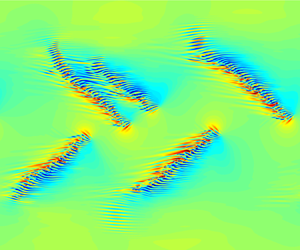Article contents
Trigger turbulent bands directly at low Reynolds numbers in channel flow using a moving-force technique
Published online by Cambridge University Press: 02 October 2020
Abstract

We show a method, for direct numerical simulations, to trigger and maintain turbulent bands directly at low Reynolds numbers in channel flow. The key is to impose a moving localised force which induces a local flow with sufficiently strong inflectional instability. With the method, we can trigger and maintain turbulent bands at Reynolds numbers down to  $Re\simeq 500$. More importantly, we can generate any band patterns with desired relative position and orientation. The usual perturbation approach resorts to turbulent fields simulated at higher Reynolds numbers, random noise or localised vortical perturbation, which neither assures a successful generation of bands at low Reynolds numbers nor offers a control on the orientation of the generated bands. A precise control on the position and orientation of turbulent bands is important for the investigation of all possible types of band interaction at low Reynolds numbers and for understanding the subcritical transition in channel flow.
$Re\simeq 500$. More importantly, we can generate any band patterns with desired relative position and orientation. The usual perturbation approach resorts to turbulent fields simulated at higher Reynolds numbers, random noise or localised vortical perturbation, which neither assures a successful generation of bands at low Reynolds numbers nor offers a control on the orientation of the generated bands. A precise control on the position and orientation of turbulent bands is important for the investigation of all possible types of band interaction at low Reynolds numbers and for understanding the subcritical transition in channel flow.
- Type
- JFM Papers
- Information
- Copyright
- © The Author(s), 2020. Published by Cambridge University Press
References
REFERENCES
- 11
- Cited by



